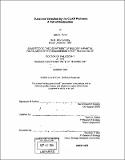| dc.contributor.advisor | Tania A. Baker. | en_US |
| dc.contributor.author | Flynn, Julia M., 1976- | en_US |
| dc.contributor.other | Massachusetts Institute of Technology. Dept. of Biology. | en_US |
| dc.date.accessioned | 2005-09-27T17:41:28Z | |
| dc.date.available | 2005-09-27T17:41:28Z | |
| dc.date.issued | 2004 | en_US |
| dc.identifier.uri | http://hdl.handle.net/1721.1/28679 | |
| dc.description | Thesis (Ph. D.)--Massachusetts Institute of Technology, Dept. of Biology, September 2004. | en_US |
| dc.description | "August 2004." | en_US |
| dc.description | Includes bibliographical references (p. 195-211). | en_US |
| dc.description.abstract | (cont.) sites for CIpA and SspB; this spatial arrangement of signals allows for efficient modulation of proteolysis of ssrA-tagged proteins. Finally, additional substrates whose degradation may be regulated by the adaptor protein SspB were determined by identifying substrates captured in ClpXP[trap] in an sspB⁺ strain but not an sspB⁻ strain. This analysis led to the identification of the N-terminal fragment of RseA, the master regulator of the extracytoplasmic stress response, as a protein whose ClpXP-mediated degradation is also enhanced by SspB. Degradation of N-RseA leads to activation of [sigma]E and thus induction of the extra-cytoplasmic stress response. This thesis work has contributed to the understanding of how intracellular proteolysis is regulated to accommodate the selective degradation of a broad range of substrates. ClpXP uses an assortment of recognition strategies, including degradation tags and adaptor proteins, in a combinatorial fashion to regulate protein degradation. | en_US |
| dc.description.abstract | Intracellular proteolysis plays a vital role in many regulatory pathways, helping cells survive a battery of stresses including oxidative damage, heat shock, and starvation. The majority of cellular proteins are degraded very slowly; however, certain proteins are extremely unstable. The concentration of unstable regulatory proteins can be adjusted quickly in response to altered cellular conditions by changes in their rate of degradation and synthesis. In addition, proteases can remove proteins from the cell when their activities are no longer required. Proteolysis is thus a powerful mechanism to regulate many cellular pathways. To execute these tasks, it is imperative that intracellular proteases select their substrates swiftly and discerningly. This thesis explores the strategies used by the Escherichia coli energy-dependent protease, ClpXP, to correctly select its substrates for destruction. Prior to our work, only a small group of ClpXP substrates were known. To identify a larger group, we captured intact substrates in vivo inside of a ClpXP[trap]. Sequence analysis of these identified substrates combined with peptide binding experiments revealed five common motifs that are directly recognized by CIpXP, representing the first general description of rules governing substrate recognition by this protease. Direct recognition of these accessible degradation tags can be further modulated by adaptor proteins. SspB is an adaptor protein identified for its ability to enhance the degradation of ssrA-tagged proteins by ClpXP. We dissected the sequence information in the ssrA tag required for recognition by ClpX, SspB, and ClpA, another ClpP partner. The ssrA tag contains contiguous bindings sites for CIpX and SspB, but | en_US |
| dc.description.statementofresponsibility | by Julia M. Flynn. | en_US |
| dc.format.extent | 211 p. | en_US |
| dc.format.extent | 10281490 bytes | |
| dc.format.extent | 10308691 bytes | |
| dc.format.mimetype | application/pdf | |
| dc.format.mimetype | application/pdf | |
| dc.language.iso | en_US | |
| dc.publisher | Massachusetts Institute of Technology | en_US |
| dc.rights | M.I.T. theses are protected by copyright. They may be viewed from this source for any purpose, but reproduction or distribution in any format is prohibited without written permission. See provided URL for inquiries about permission. | en_US |
| dc.rights.uri | http://dspace.mit.edu/handle/1721.1/7582 | |
| dc.subject | Biology. | en_US |
| dc.title | Substrate selection by the ClpXP protease : a tail of destruction | en_US |
| dc.type | Thesis | en_US |
| dc.description.degree | Ph.D. | en_US |
| dc.contributor.department | Massachusetts Institute of Technology. Department of Biology | |
| dc.identifier.oclc | 58995200 | en_US |
